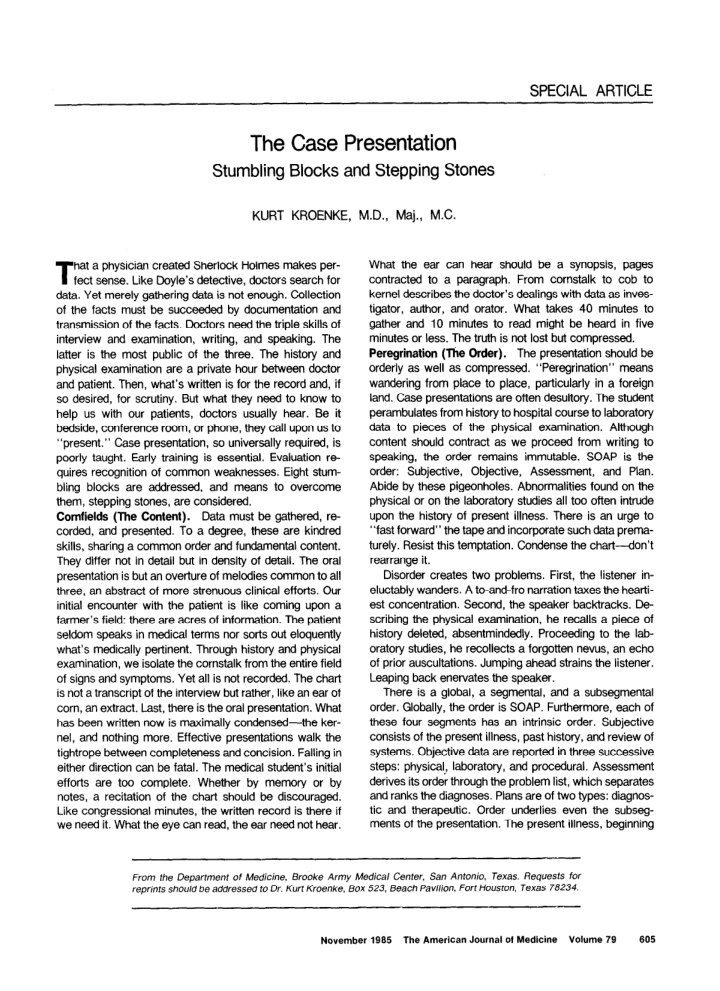



SPECIAL ARTICLE The Case Presentation Stumbling Blocks and Stepping Stones KURT KROENKE, M.D., Maj., M.C. T What the ear can hear should be a synopsis, pages hat a physician created Sherlock Holmes makes per- fect sense. Like Doyle’s detective, doctors search for contracted to a paragraph. From cornstalk to cob to kernel describes the doctor’s dealings with data as inves- data. Yet merely gathering data is not enough. Collection of the facts must be succeeded by documentation and tigator, author, and orator. What takes 40 minutes to transmission of the facts. Doctors need the triple skills of gather and 10 minutes to read might be heard in five interview and examination, writing, and speaking. The minutes or less. The truth is not lost but compressed. latter is the most public of the three. The history and Peregrination (The Order). The presentation should be physical examination are a private hour between doctor orderly as well as compressed. “Peregrination” means wandering from place to place, particularly in a foreign and patient. Then, what’s written is for the record and, if land. Case presentations are often desultory. The student so desired, for scrutiny. But what they need to know to perambulates from history to hospital course to laboratory help us with our patients, doctors usually hear. Be it bedside, conference room, or phone, they call upon us to data to pieces of the physical examination. Although “present.” Case presentation, so universally required, is content should contract as we proceed from writing to speaking, the order remains immutable. SOAP is the poorly taught. Early training is essential. Evaluation re- quires recognition of common weaknesses. Eight stum- order: Subjective, Objective, Assessment, and Plan. bling blocks are addressed, and means to overcome Abide by these pigeonholes. Abnormalities found on the them, stepping stones, are considered. physical or on the laboratory studies all too often intrude Cornfields (The Content). Data must be gathered, re- upon the history of present illness. There is an urge to corded, and presented. To a degree, these are kindred “fast forward” the tape and incorporate such data prema- skills, sharing a common order and fundamental content. turely. Resist this temptation. Condense the chart-don’t They differ not in detail but in density of detail. The oral rearrange it. presentation is but an overture of melodies common to all Disorder creates two problems. First, the listener in- eluctably wanders. A to-and-fro narration taxes the hearti- three, an abstract of more strenuous clinical efforts. Our est concentration. Second, the speaker backtracks. De- initial encounter with the patient is like coming upon a farmer’s field: there are acres of information. The patient scribing the physical examination, he recalls a piece of seldom speaks in medical terms nor sorts out eloquently history deleted, absentmindedly. Proceeding to the lab- what’s medically pertinent. Through history and physical oratory studies, he recollects a forgotten nevus, an echo of prior auscultations. Jumping ahead strains the listener. examination, we isolate the cornstalk from the entire field of signs and symptoms. Yet all is not recorded. The chart Leaping back enervates the speaker. is not a transcript of the interview but rather, like an ear of There is a global, a segmental, and a subsegmental corn, an extract. Last, there is the oral presentation. What order. Globally, the order is SOAP. Furthermore, each of has been written now is maximally condensed-the ker- these four segments has an intrinsic order. Subjective nel, and nothing more. Effective presentations walk the consists of the present illness, past history, and review of systems. Objective data are reported in three successive tightrope between completeness and concision. Falling in either direction can be fatal. The medical student’s initial steps: physical,, laboratory, and procedural. Assessment derives its order through the problem list, which separates efforts are too complete. Whether by memory or by notes, a recitation of the chart should be discouraged. and ranks the diagnoses. Plans are of two types: diagnos- tic and therapeutic. Order underlies even the subseg- Like congressional minutes, the written record is there if we need it. What the eye can read, the ear need not hear. ments of the presentation. The present illness, beginning From the Department of Medicine, Brooke Army Medical Center, San Antonio, Texas. Requests for reprints should be addressed to Dr. Kurt Kroenke, Box 523, Beach Pavilion, Fort Houston, Texas 78234. November 1985 The American Journal of Medicine Volume 79 605
Recommend
More recommend